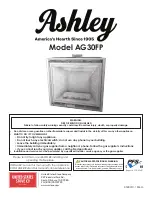
„Installation and operation manual for fireplace insert”
19
b) radiation: heat is given off through the glass pane and steel body of the device.
2.2 Lighting up
NOTE! If the KFD ECO fireplace insert is not used for a prolonged time, before lighting up
check if the chimney is passable.
The fireplace heating system you have purchased is an ecological, economical and efficient
system which
– apart from obvious economic advantages – can give you a lot of pleasure by
creating a very pleasant and cosy atmosphere at home, with the fireplace burning with real
fire. However, to be able to fully enjoy the atmosphere, you should first acquire certain skills
required to be able to effectively and comfortably make the best of all advantages of the
fireplace.
The fundamental skill you need to acquire at the beginning is how to light up fire in the
fireplace. Although it may seem banal, it does require some skill. You need to realise that a
cold furnace and chimney may result in penetration of a considerable quantity of smoke into
the room. To prevent that, start with lighting up a few scrunched up sheet of paper in the
furnace. Please remember that both the chimney damper (adjuster at the top of the furnace)
and the air supply (at the bottom of the furnace) need to be set in the open position
(maximum to the right). After initial heating up of the furnace, proceed to placing scrunched
up newspapers first, fine slivers of wood (preferably
– placed vertically), followed by slightly
thicker pieces of wood. The load of fuel prepared as above can now be lit up at the bottom.
Then, push the door ajar, leaving a small gap (of a few centimetres). This stage of lighting up
requires constant control of fire by the user, allowing determination of the right moment to
add thick chunks of wood and to close the door. From now on, the process of lighting up
proceeds with the air inlet (bottom lever) open to the maximum and with open chimney
damper (top lever). The fireplace may burn at these settings for a few up to over ten minutes,
until fire spreads over all fuel in the furnace. By then, the turbine pushing hot air into
particular rooms should be activated automatically, if the hot air distribution system is
equipped with a turbine. Now, add a full load of fuel (5 kg of wood
– several finer chunks with
the length of 33 cm) and close the chimney damper. From now on, control the combustion
rate exclusively by the supply of air (handle at the bottom of the furnace). The position of the
adjustment handle and, consequently, the combustion rate are to be set so as not to exceed
the combustion rate of 4 kg of wood per hour (in most cases, this corresponds to the central
position of the bottom handle). Greater combustion rate involves emission of power
exceeding rated power of the insert, and involves the risk of thermal overloading. From now
on, the fireplace does not require the user’s intervention except for adding wood. the
Chimney damper must be opened whenever the door of the furnace is to be opened,
otherwise, smoke from the furnace will come out to the room. The frequency of adding fuel
depends on several factors: position of adjustment elements, quality of used wood and
chimney draught which also depends on the weather.
An excessive quantity of wood and an excessive quantity of combustion air may cause
overheating and, consequently, damage to the fireplace insert.
When the door of the fireplace insert is being opened (for lighting up and adding of fuel), the
chimney damper of the fireplace insert must be opened. Otherwise, smoke will come out to
the room where the fireplace is installed. During normal operation of the fireplace, the
chimney damper ought to be closed. To avoid smoking of the room, fuel should only be
supplemented during the final stage of combustion, i.e. when only a layer of embers remains
in the furnace. The furnace door is to be opened slowly to equalise the pressures and avoid
smoking, and it is to be closed immediately after adding fuel.
If fuel is added at longer intervals, when there is only a layer of embers in the furnace, the
lighting up process ought to be divided into two stages. During the first stage, add only 1 or 2
















































